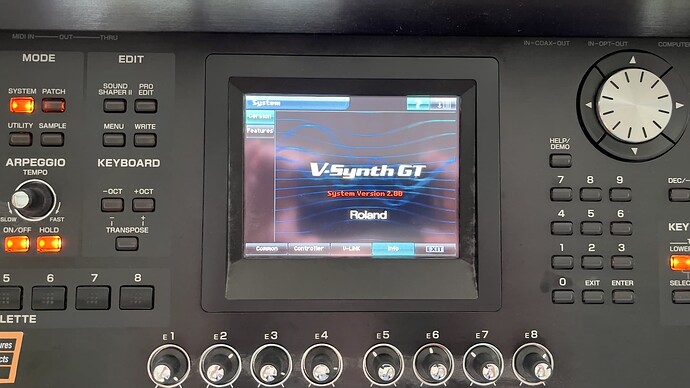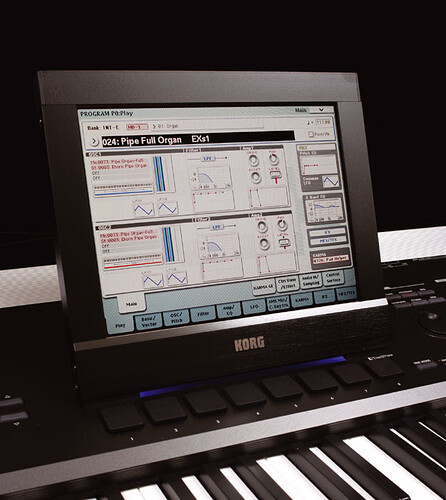I am using V-synth GT after a 10-year break. Nostalgia has choked me and here it is again “hello!”, I thought:
the motivation is as follows: the Korg Kronos mk1 of that time of design has an 8" display 800x600 SVGA, TouchView. And compared to the authoritative old man Korg OASYS with 10.4" (640 x 480) - a legend from the same 2005, V-synth GT looks quite shameful… :?
Nevertheless, I thought about how to fit the new LCD display into the size of the old plastic frame (the dimensions of the frame opening are 155x135 mm or 205 mm = 7.9~8.0 inches diagonally). or in the case of a wide screen with an aspect ratio not 4:3 but wider, so you may to use the central area width of 19-20 cm and make a rotating frame-transformer like the OASYS:
Since I have experience replacing LCD-chart screens on old synthesizers and new ones memories from replacing non-original touchpads (
Korg Z1 touchpad). It would be interesting to hear the opinions of those who have done similar tricks?!
From the datasheet for the C1D13742 LCD controller it is known that:
• Supports TFT panels
• 18/36-bit RGB interface
• Supports resolution up to 800x480 pixels!
Such a controller can provide operability for a TFT display up to 7" and more than 8 inch… (but we must adhere to the possibility of non-destructive replacement due to the existing frame on the front panel of the V-synth)
I have doubts that unless in the V-synth_GT service manual may be another LCDC from this family is installed, but with weaker suitable characteristics C1D13743 is maximum up to 352x440, which is suitable for the declared characteristics of the V-synth GT screen (320x240) 
You won’t be able to increase the resolution. The synth is rendering a set resolution and you can’t change that without rewriting the OS routines. The CPU might not even be up to the job of rendering a higher resolution too. You’re only chance IMHO is to find a screen that is bigger with exactly the same resolution and chipset.
1 Like
Thanks for the comment…
but it would be nice to have information about the engineering service mode and its current V-synth GT peripheral settings.
If that fails, I’ll have to think about other hacks, for example:
Migration to Larger Panels: LCD controllers like the Epson S1D13748 utilize pixel doubling to easily adapt to larger display sizes without requiring significant changes to the image data.
Or try to find a QVGA scaller/converter, which would intercept RBG signals and scale them for a VGA display?
What do you think about that?
Isn’t the V-Synth GT a touch screen?
So, data sheets reading primers does wonders! Judging by the host parameters supply specified in SM (if I didn’t make a mistake in choosing the data table according to the bit depth (16bit) and RGB565 depth = 65K) for IC38 (S1D13742 Mobile Graphics Engine)
I found outed this table of signal encoding for RGB(565):
in which I did not quite understand the essence of the mapping between controls & picture data flow (indicated in the red frame), correct me if I am wrong in the following conclusion:
shortly: control data bits are in the first pulse events on the parallel channels:
- MSB - MD15 (PIN #131)
- LSB - MD0 (PIN #101)
which we need to catch and reproduce correctly MD0 = [01h] for dubbing cell mode of picture (highlighted in yellow) which addressing to REG[36h],..
while to catch addressing to REG[36h] (Special Effects Register), you need to IC22 produced that control signal to transfer from IC23A PIN#6
and at these control points it is necessary to install the Arduino translator to convert the control bit MD0 = [01h] together with the rest of the parallel bits coming from the host (and for all other image data - the transparency of the transfer without changes is necessary) for IC38 (S1D13742 Mobile Graphics Engine)
Only I still don’t understand the following solutions on SM (picture above):
-
how does IC38 LCD controller work with xWR16 signal from IC25A (in red square mark)
-
op-amps IC22; 24; 26 HD74LV245ATELL can work as bidirectional 8-bus keys, then doesn’t it follow from this that there is bidirectional communication between the host and the LCD controller during the initial boot-start and bypass for coordinating the “rules of the game” and possible parameters like QVGA/VGA/WVGA of the supported monitor panel? is this survey possible?
-
how does the initial setup of the screen window occur? at the very beginning of the OS launch or every time before redrawing the screen image? since the difficulty is that reverse engineering for the screen periphery will be a very complex project, and I was unable to get into the engineering menu…
Google searches do not provide an answer to this request, and AI does not deny that such a synthesizer mode exists! therefore - if anyone knows how to get to this complementary menu of V-synth GT settings - I will be grateful!
Please, correct me if anyone understands…
![]()






